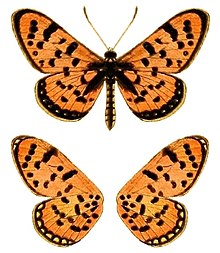| Speckled red acraea | |
|---|---|

| |
| Dorsal aspect of imago, and ventral aspect of wings | |
| Conservation status | |
 Least Concern (IUCN 3.1) | |
| Scientific classification | |
| Domain: | Eukaryota |
| Kingdom: | Animalia |
| Phylum: | Arthropoda |
| Class: | Insecta |
| Order: | Lepidoptera |
| Family: | Nymphalidae |
| Genus: | Acraea |
| Species: | A. violarum |
| Binomial name | |
| Acraea violarum Boisduval, 1847 | |
| Synonyms | |
| |
Acraea violarum, the speckled red acraea, is a butterfly of the family Nymphalidae which is native to southern Africa.
Range
It is found in KwaZulu-Natal, Transvaal, Zimbabwe and southern Mozambique. It is a variable species with a number of described morphs including form violarum, form assimilis and form gracilis.
Description
For a key to the terms used, see Glossary of entomology terms.The wingspan is 40–48 mm for males and 43–55 mm for females. A. violarum Bdv. (55 a). Wings above with dull brick-red to grey-red to grey (female) ground-colour and large black dots; forewing with fine black marginal line, which is widened at the apex into a spot 2 mm. in breadth, and with 6 submarginal dots (in 1b to 6); both wings above more or less darkened at the base; marginal band of the hindwing with the proximal boundary lunulate; under surface almost as the upper, but the marginal band of the hindwing with large whitish spots and the forewing at the apex with small marginal spots of the same colour. South Africa to Angola and Mashonaland.
Biology
Adults are on wing year round, with a peak from July to November.
The larvae feed on Basananthe sandersonii. Adults have been found feeding on flower nectar of Scabious species.
Taxonomy
It is a member of the Acraea cepheus species group – but see also Pierre & Bernaud, 2014.
References
- Woodhall, S. E.; Westrip, J. R. S. (2020). "Acraea violarum". IUCN Red List of Threatened Species. 2020: e.T161327982A161327995. doi:10.2305/IUCN.UK.2020-3.RLTS.T161327982A161327995.en. Retrieved 18 November 2021.
- Boisduval, J. B. A. 1847. Catalogue des Lépidoptères recuillie par M. Delagorgue pendant les années 1838-1844 à Port-Natal, au pays de Amazoulous et dans la contrée de Massilicatzi. In: Delegorgue, M. A. Voyage dans l’Afrique australe 2: 585-602. Paris.
- "Acraea Fabricius, 1807" at Markku Savela's Lepidoptera and Some Other Life Forms
- Aurivillius, C. 1908-1924. In: Seitz, A. Die Großschmetterlinge der Erde Band 13: Abt. 2, Die exotischen Großschmetterlinge, Die afrikanischen Tagfalter, 1925, 613 Seiten, 80 Tafeln (The Macrolepidoptera of the World 13). Alfred Kernen Verlag, Stuttgart.
 This article incorporates text from this source, which is in the public domain.
This article incorporates text from this source, which is in the public domain.
- Woodhall, Steve (2005). Field Guide to Butterflies of South Africa. Cape Town, South Africa: Struik. ISBN 978-1-86872-724-7.
- Pierre & Bernau, 2014 Classification et Liste Synonymique des Taxons du Genre Acraea pdf
External links
| Taxon identifiers | |
|---|---|
| Acraea violarum | |
This Heliconiinae article is a stub. You can help Misplaced Pages by expanding it. |